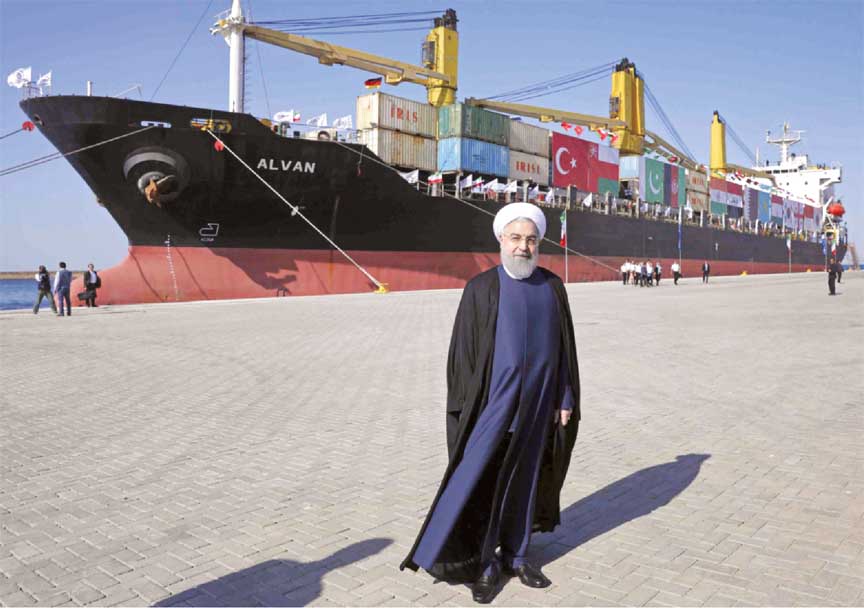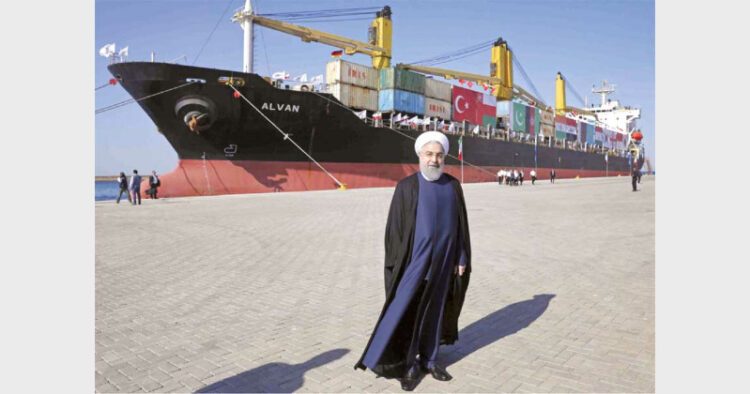 While Gwadar port has enabled China to remain in close proximity of Gulf and Indian Ocean region, Chabahar will enable India to closely monitor the Chinese activities and give strategic edge to India in many ways
While Gwadar port has enabled China to remain in close proximity of Gulf and Indian Ocean region, Chabahar will enable India to closely monitor the Chinese activities and give strategic edge to India in many ways
Brig (Retd) Anil Gupta
Chabahar is a deep-sea port located in Sistan Baluchistan area of Iran at the mouth of Gulf of Oman. It is a strategically located port because it provides direct access to the Indian Ocean enabling bypassing of Strait of Hormuz, a traditional choke point, that separates Persian Gulf from the Gulf of Oman and the Indian Ocean. Incidentally, 1/5th of oil consumed worldwide currently passes through the Strait of Hormuz. Chabahar lies outside the Persian Gulf and is easily accessed from India’s Western Coast. The distance from New Delhi to Mumbai is more than the distance from Kandla Port on Western Coast to Chabahar. It is located 45 nautical miles away from the port of Gwadar built by China in Pakistan’s Baluchistan. Gwadar is the outlet to Indian Ocean from the proposed China-Pakistan Economic Corridor (CPEC) termed as a “Game Changer” in the region by both the Chinese and the Pakistan. Gwadar provides tremendous strategic advantage to China not only in its pursuit of encircling India but also in the domination of Indian Ocean an unchallenged domain of India so far.
Effective Counter to China
A major geo-strategic factor that affected India’s outreach to strategically important Afghanistan and oil and mineral rich Central Asian Republic (CAR) is the continuous reluctance of Pakistan to allow access to these land locked regions through its territory being the only over-land access presently. This has not only hampered India’s economic interests but its security concern as well because of the lack of direct access to the terror ridden nations in the region. Pakistan enjoyed a geo-strategic advantage in War on Terror against Afghanistan and hence enjoyed American largesse despite enough evidence to prove its involvement in not only sheltering the terrorist leaders but perpetrating terror in South Asia particularly India and Afghanistan. The commissioning of Chabahar will not only provide India much needed access to Afghanistan and give boost to its “connect-Central Asia” policy but will also seize the strategic initiative back both from Pakistan and China. It will also act as an effective counter to China’s “String of Pearls” strategy in the Indian Ocean due to its location viz a viz Gwadar. It will also help India to fight terror and extremism in the region jointly with the regional players thus isolating Pakistan. Pakistan rightly views India’s so-called “Expansive Diplomacy” in the region as a threat whereas India looks at it as an opportunity for furtherance of its economic and strategic interests in the region.
New Opportunities for Trade
Chabahar port is being expanded by India as an alternate, reliable and robust connectivity for Afghanistan following Pakistan”s refusal to allow India access via its territory to Afghanistan. It will open up new opportunities for trade and transit from and to Afghanistan and enhance trade and commerce between India, Afghanistan, Iran and the wider region. It will open up route to
land-locked Afghanistan where India has developed close security ties and economic interests. Iran has already built a road, with financial aid from India, from Chabahar to Milak on Iran-Afghan border. It has further been linked to the Zaranj-Delaram road constructed by the Indian Border Roads Organisation (BRO) in 2009 which provides access to Afghanistan’s Garland Highway providing connectivity to four major towns of Afghanistan namely Herat, Kandahar, Kabul and Mazar-e-Sharif. India is also constructing a railway line between Chabahar and Zahedan to connect the port to rest of the Iranian railway network. The port, through this railway network, could also be linked with the International North South Transport Corridor connecting India with Russia. India has also announced its intention to link Afghanistan with rail network. It will also enable Afghanistan to carry out international trade without its dependence on Pakistan’s Karachi port. Afghanistan’s dependence on Pakistan will be considerably reduced thus reducing Pakistan’s influence in the region. The opening of Chabahar route will increase Iranian and Indian influence in Afghanistan leading
to Pakistan’s marginalisation. Thus, Pakistan’s policy of “Strategic Depth” against India will suffer a severe jolt.
As mentioned, the Chabahar port will also give boost to the strategic International North-South Transport Corridor (INSTC) by being its natural outlet to the Ocean. INTSC is an ambitious project to connect India to European and Central Asian markets through a network of ship, rail and land route. It will connect India to Russia via Iran and Azerbaijan. With India’s access to CAR nations blocked by Pakistan INSTC will provide India the vital access to the Central Asian, Russian and European markets enabling India to compete with China. The aim behind INSTC is to cut transportation costs giving boost to better trading margins while competing in these markets. Compared to the current traditional sea route to Europe via the Suez Canal, Chabahar-INSTC is 40 per cent shorter and reduces the cost of Indian trade to Europe by 30 per cent. Moreover, international trade will be able to overcome the uncertainties of “Sea Politics” in the volatile Middle- East with the availability of an alternative. China’s ambitious China-Pakistan Economic Corridor (CPEC) providing China international connectivity via Gwadar port passes through the most troubled areas in Pakistan and is vulnerable to many security challenges. The route from Chabahar to Afghanistan via Iran and the INSTC passes through relatively peaceful regions of Afghanistan thus making Chabahar a natural winner viz a viz Gwadar as a preferred port for the international trading community and earning a greater share of trade.
A Great Strategic Asset
With the inauguration of first phase of the ambitious Chabahar Project at Shahid Beheshti, India has turned the table both on China and Pakistan, her geopolitical rivals in the area. The port of Chabahar when fully functional will be a great strategic asset for India. With the Indian Navy acquiring a base at Changi (Singapore), India’s domination in the Indian Ocean will be unchallenged apart from India gaining a strategic trade corridor. While the Chabahar port is essentially meant for commercial purposes and provides transit route to Afghanistan, India can use the facility to monitor Pakistani & Chinese activities in the Indian Ocean Region as well as Gulf. It could be convenient location for India to monitor activities of Pakistani Navy. While Gwadar port has enabled China to remain in close proximity of Gulf and Indian Ocean region, Chabahar will enable India to closely monitor the Chinese activities. Chabahar port would give New Delhi a base to position itself after international troops withdraw from Afghanistan.
India’s increased presence in the region would also enable her to become a significant player in the Middle-East. India’s influence over Chabahar could be leveraged in many ways. India’s energy security needs would also be addressed with the option of bypassing Pakistan. Turkmenistan-Afghanistan-Pakistan-India (TAPI) gas pipeline project can now be diverted directly from Afghanistan to India via Chabahar. So far India’s gas imports are confined to Oman only. Undersea gas pipelines can also be laid to bring gas from Oman, Iran & CAR nations to Indian ports on Western Coast. It will to a great extent meet India’s energy requirement so vital for her growth.
Nevertheless, the region is going to witness intense competition between China & India for its domination. Chabahar provides a definite strategic edge to India and is a certain game changer in India’s favour. A word of
caution lest we are let down. The success of Indian ambition in the region to a large extent will depend on a peaceful and stable Afghanistan. India will, therefore, have to keep reviewing her strategic options to ensure that Afghanistan is not allowed to drift away from the path of peace and development. India should be prepared to thwart any evil designs against India’s strategic interests in the region. India needs to develop the capability of Out of Area intervention to protect her strategic interests. A complete sync between India’s foreign and defence policy is mandatory.
(The writer is a Jammu-based security and strategic analyst)













Comments